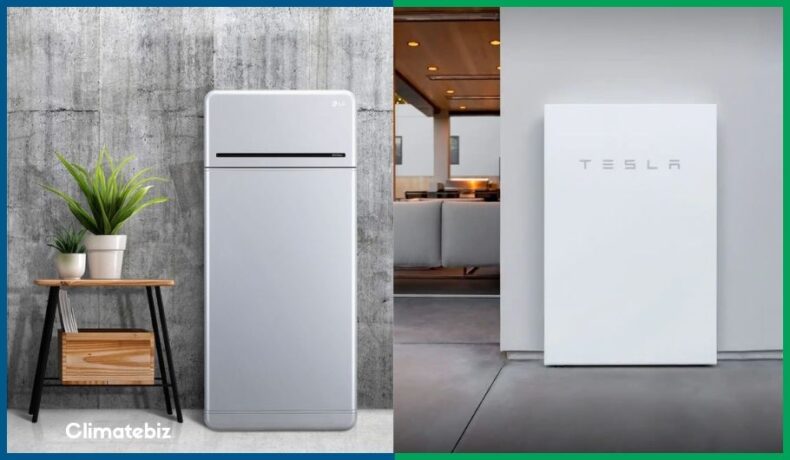
LG Energy Solution vs. Tesla Powerwall — whether you’re looking to power your off-grid property or simply wanting backup power during a power outage, these are undoubtedly both fantastic (premium) go-to options!
Find out which option is the cheapest and offers the best quality, warranty, and efficiency for storing your household’s power.
Affiliate Disclaimer
Table of Contents
LG Energy Solution Vs. Tesla Powerwall

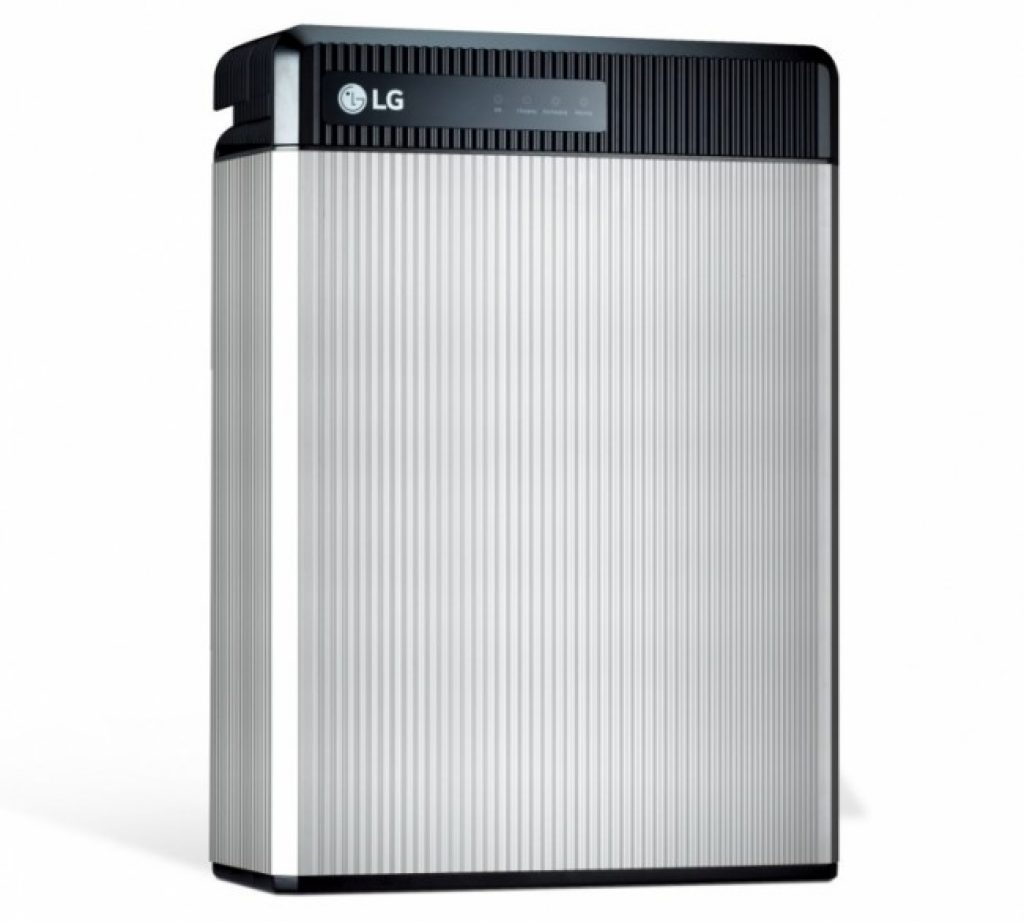
Please note: since December 2020, LG Chem and LG Energy Solution have been two separate entities. The batteries, formerly known as LG Chem, have been rebranded under the name LG Energy Solution.
LG Energy Solution and Tesla Powerwall are based on the same storage technology: lithium batteries.
However, their products offer different specifications as listed below:
| LG Energy Solution | Tesla Powerwall | |
|---|---|---|
| Storage Technology | Lithium battery | Lithium battery |
| Type of battery | DC battery – 48V | AC battery – 120/240V |
| Storage Capacity | From 3.3 to 17kWh | 13.5kWh |
| Continuous Power Output | 5kW | 5kW |
| Peak Power Output | 7kW (3sec) | 10kW (10sec) |
| Input Power | 5kW | 5kW |
| Battery efficiency | >95% | 90% |
| Scalability | 2 units | Up to 10 units |
| Size | 24.7 in x 17.8 in x 8.94 in (RESU 13) | 45.3 in x 29.6 in x 5.75 in |
| Weight | 217.2lbs (RESU 13) | 251.3 lbs |
| Warranty | 10 years – 39MWh (RESU 13) | 10 years – 37.8MWh |
| Buying price (with installation cost) | $8600(RESU 13) | $11,500 |
| LCOS (Levelized Cost of Storage) | $0.22/kWh | $0.30/kWh |
LG Energy Solution
This company is a subsidiary of LG Group, a well-known consumer electronic company. It is a major supplier of battery cells to the electric automotive industry.
Additionally, LG Energy Solution develops its own domestic electricity storage solutions under RESU (Residential Storage Unit).
So far, LG Energy Solution offers 14 batteries; their capacity varies from 17 kWh to 3.3 kWh.
The specificity of RESU batteries is their operation in DC mode.
Consequently, the LG Energy Solution RESU must be coupled to a hybrid inverter that converts DC into AC usable by all our appliances.
LG lists compatible inverters, including the following brands:
Below is a typical system layout using the LG Energy Solution RESU 13:
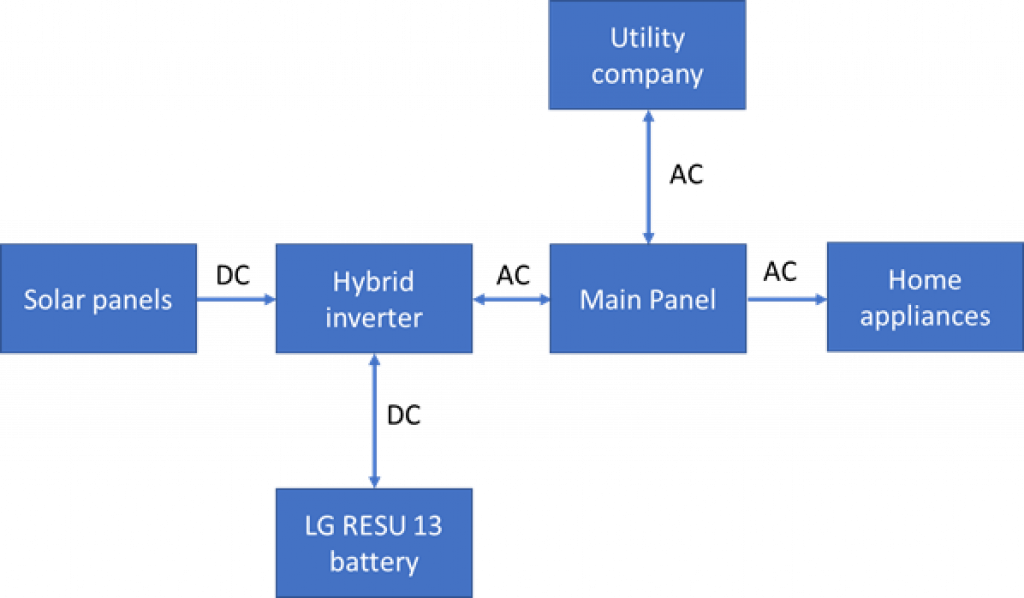
Tesla Powerwall
Tesla inc. is a US-based electric car manufacturer founded by Elon Musk in 2003. The company builds advanced electric cars and produces lithium batteries through its subsidiary Tesla Energy.
Since 2015, it has commercialized the Tesla Powerwall, a plug-and-play domestic Energy Storage Solution (ESS).
Currently, Tesla only offers one product: the Tesla Powerwall 2. Unlike the LG Energy Solution RESU, the Tesla Powerwall 2 is a full AC battery; it doesn’t require a hybrid inverter and can even operate without solar panels.
Below is a typical system layout using a Tesla Powerwall:

Related Reading: SunPower Vs. Sunrun: Which should you choose?
Which Company Produces Better Quality?
Quality-wise, Tesla’s Powerwall is the winner.
The comparative chart below shows that the Tesla Powerwall is more robust than LG’s RESU.
Although both units are designed to work outdoors, the Powerwall operates at a broader range of temperatures and has better protection against rain.
| Tesla Powerwall | LG Energy Solution RESU | |
|---|---|---|
| Environment | Outdoor and Indoor | Outdoor and Indoor |
| Operating temperature | –4°F to 122°F | 14°F to 122°F |
| Recommend operating temperature | 32°F to 86°F | 59°F to 86°F |
| Ingress rating | IP67 & IP56 | IP55 |
| Operating humidity | Up to 100% condensing | 5% to 95% |
| Max. altitude | 9800ft | 6500ft |
LG Energy Solution Vs. Tesla Powerwall: Which Company Is Cheaper?
After comparing both options at the same storage levels, we found the LG Energy Solution RESU to be cheaper than the Tesla Powerwall.
| TESLA Powerwall | LG Energy Solution | |
|---|---|---|
| Buying price (including installation cost) | $11,500 | $8,600 (RESU 13) |
| LCOS (Levelized Cost of Storage) | $0.30/kWh | $0.22/kWh |
The above table uses the Levelized Cost of Storage (LCOS) in USD/kWh.
LCOS is calculated by dividing the price of one unit by the total energy it will store and release (charge & discharge) over its lifetime.
The LG Energy Solution offers 39 MWh of total storage, whereas the TESLA Powerwall is rated at 37.8 MWh.
In the end, the LCOS of the LG RESU (0.22 USD/kWh) is lower than the Tesla Powerwall (0.3 USD/kWh).
We can compare those figures to the average US electricity price: $0.146/kWh (up to $0.37/kWh in Hawaii).
Important To Remember:
The Tesla Powerwall is an AC battery; therefore, you can connect it to a regular grid-tied solar inverter.
The LG Energy Solution RESU is a DC battery; therefore, you can connect it to a hybrid inverter (also called an off-grid inverter). Hybrid inverters are more expensive than grid-tied inverters.
Related Reading: SunPower Vs. Tesla (Which brand should you choose?)
LG Energy Solution Vs. Powerwall: Which Has Better Efficiency?
LG’s Energy Solution RESU is more efficient than the Powerwall.
| TESLA Powerwall | LG Energy Solution | |
|---|---|---|
| Round trip efficiency | 90% | >95% |
The TESLA Powerwall is an AC battery, meaning it has lower efficiency.

Related Reading: Top 7 Tesla Powerwall Alternatives
Which Company Product Has A Better Warranty?
LG Energy Solution RESU 13 has a slightly better warranty than the Tesla Powerwall 2.
Both products offer a 10-year warranty. However, Tesla estimates the lifetime storage capacity of its unit to 37.8MWh vs. 39MWh for the RESU 13 — the LG unit has 3% more storage capacity.
Which Product Is Right For You?
If you’re looking for more autonomy, we recommend the Tesla Powerwall.
You can connect up to 10 units in parallel, bringing your total storage capacity to 135kWh (an average household in the US uses 30kWh per day). This is enough for a small-medium size commercial operation.
Should you require an option for smaller capacities (from 3kWh to 10kWh), then the LG Energy Solution is the way to go. This storage option is perfect for UPS (uninterrupted power supply) backup during a short power outage.
Please note: since 2021, Tesla only sells the Powerwall combined with a Tesla solar system installation.
Final Thoughts
Tesla and LG Energy Solution both offer great quality domestic batteries.
The major drawback of the Tesla Powerwall is that you need to purchase an accompanying Tesla Solar system. In contrast, you can add the LG Energy Solution to any existing solar system.
If you’re still unsure, here are the best batteries across 8 categories:
- Price: LG Energy Solution
- Storage Capacity: Tesla
- Warranty: LG Energy Solution
- Efficiency: LG Energy Solution
- Plug-and-Play: Tesla
- Quality: Tesla
- Service: Tesla
- Availability: LG Energy Solution
If you want to share your thoughts or ask us a question, please feel free to reach out to us in the comments section below! Alternatively, visit our forum or follow us on Twitter to share your opinions!


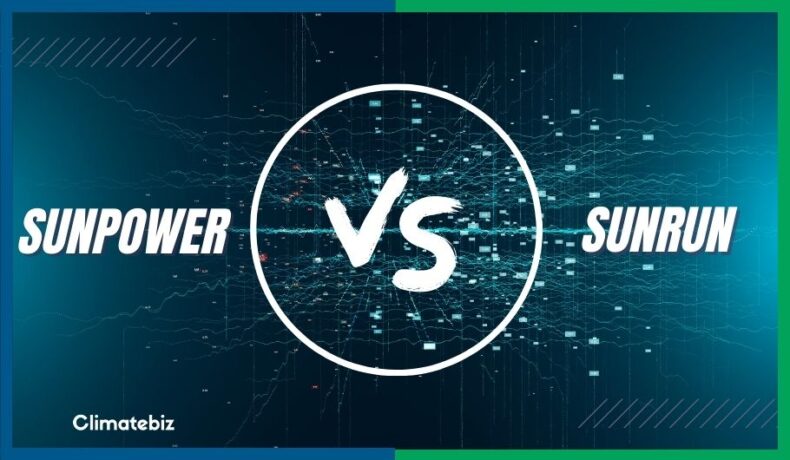
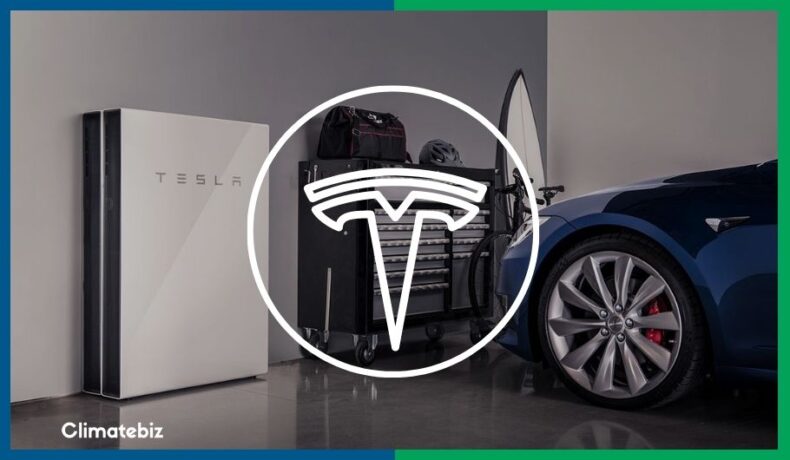





If the LG Battery MUST be used with a hybrid inverter, shouldn’t the price of that be included in the calculation of operating cost and efficiency?
In the calculation of best warranty based on storage capacity over the lifetime, why not factor USABLE capacity to consider inverter loss?
Yes, you are right. The LG battery supplies DC electricity and must be paired with a hybrid inverter.
To be fair, the Powerwall (AC battery), if connected to a solar system, also needs an inverter, as solar panels produce DC. It could be a micro-inverter for each solar panel.
In this article, we focused only on each product as a single battery.
But included in a solar system, they both need inverters.
For the LG, a 5kW hybrid inverter will do the job. Sol-Ark is a good choice. Their 5kW model is 5’000USD. That would add to the 8600$ of the RESU13, a total of 13600$. Then the LG becomes more expensive than the Powerwall.
But the LG+inverter can directly accept solar panels, whereas the Powerwall will require an extra expense that will depend on the number of solar panels installed.
Regarding your second question, if the Powerwall guarantees 37.8MWh, this is AC directly usable by our appliances. The LG guarantees 39MWh in DC. If the conversion efficiency of the LG inverter is 95%, that translates into 37.05MWh AC which is very similar to the Powerwall. Totally agree.
However, the efficiency that LG loses with its DC to AC inverter, the Powerwall also loses with its micro inverters (Emphase micro-inverters are 96.5% efficient).
In the end, if integrated with a solar system, both of their energy guarantees in AC are pretty similar, with LG maybe 1-2% higher.
I hope this helps!